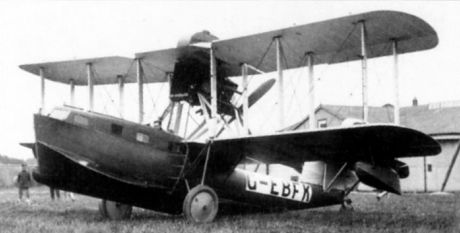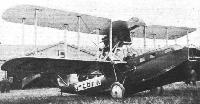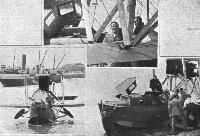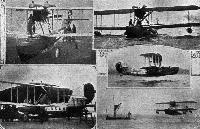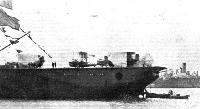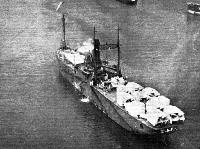Supermarine Sea Eagle и Scarab
Компания "Supermarine" разработала и построила три летающие лодки - амфибии Sea Eagle, выполненные по схеме биплана. На них был установлен ПД Rolls-Royce Eagle IX мощностью 360 л. с. (268 кВт), экипаж состоял из двух человек, а закрытая кабина была рассчитана на шесть пассажиров.
Первый Sea Eagle, поднявшийся в воздух в июне 1923 года, был предназначен для авиакомпании "British Marine Air Navigation Company", организовавшей перевозки пассажиров между Саутгемптоном и Нормандскими островами. Первый рейс состоялся в начале июля 1923 года. Маршрут между Саутгемптоном и островом Гернси, открытый 25 сентября 1923 года, стал первой в Британии регулярной авиалинией, и один из трех уцелевших Sea Eagle эксплуатировался на ней до конца 1928 года. Позднее этот самолет использовался авиакомпанией "Imperial Airways".
В начале 1924 года "Supermarine" получила заказ от морской авиации Испании на 12 летающих лодок - амфибий, для использования в качестве разведчиков/бомбардировщиков. Созданный самолет, получивший имя Scarab, был милитаризованным вариантом Sea Eagle, сохранив силовую установку последнего. В открытых, тандемно расположенных кабинах, размещались пилот и стрелок, а кабина штурмана-радиста была закрытой. Вооружение состояло из одного 7,7-мм пулемета Lewis на турели Scarff у стрелка, двенадцати 23-кг бомб на револьверном держателе в корпусе лодки и четырех 45-кг бомб на подкрыльевых держателях.
Самолет был построен и поставлен заказчику в 1924 году, но о дальней его судьбе информация отсутствует.
Показать полностьюShow all
Flight, June 1923
THE SUPERMARINE "SEA EAGLE"
Rolls Royce "Eagle IX" Engine
As believers in and champions of the commercial seaplane, it is with considerable satisfaction that we are able this week to announce that the Supermarine Aviation Works, Ltd., of Southampton, have now completed and tested the first of their modern commercial flying boats, the "Sea Eagle," intended for use on the new Cross-Channel Air Services. The shops at Woolston have always been devoted to the production of seaplanes, and the firm's designers have concentrated on this type for a matter of ten years or more. Persevering, often in spite of scant official encouragement, buoyed up by their belief in the ultimate success of the seaplane, and especially the flying boat, Mr. Scott Paine, Commander Bird, and those associated with them, have resisted the temptation to switch over to aeroplane construction, although to have done so might, and probably would, have resulted in considerable immediate gains. It is an unfortunate fact that so little interest has the Air Ministry of the past had in the flying boat that it has been much easier for a firm to get an aeroplane design accepted than a design for a new type of flying boat. It is, therefore, all the more to the credit of the Supermarine Works that they have retained their faith in the seaplane and, by careful management, have been able to carry-on with their development work on types which offer far greater problems than does any new type of land machine.
Fortunately there are signs that the present Air Ministry is beginning to realise the vast possibilities of the seaplane, but there is still a great deal of reorganisation to be done in the Air Ministry departments before one can be certain that the seaplane will be given the attention it merits. It is no longer a secret that there are precious few, if any, officials left in the technical departments who have special knowledge of seaplanes, and there are instances of technical men with specialist training in seaplane work who are now occupied in departments where their knowledge is of no use to them, nor to the Air Ministry. Knowing this, one can the better understand why units working with the Navy have to go to sea on land machines when, according to all common sense, they ought to be equipped with proper seaworthy seaplanes. When fleet spotters are mentioned in these days it appears that the technical experts at the Air Ministry can only think in terms of land machines. Yet it would appear obvious that this function should be performed as a matter of course by seaplanes. However, as already mentioned, there are signs that indicate a realisation in official quarters of the absurdity of this policy, and consequently we may hope in the future to see the seaplane receive the fair share of development which in the past has been denied it. Incidentally, when this happens there will be less cause for complaint by the Navy of lack of understanding of its particular requirements.
For several years FLIGHT has made itself the champion of the commercial seaplane, and we have so often pointed out the advantages of this type of machine that there is no need to repeat the arguments here. Suffice it to say that in the supermarine "Sea Eagle," which has just completed its trials in the air, on land, and on the sea, we have the first modern flying boat specially designed for commercial conditions. The trials have shown the machine to be seaworthy, to handle exceptionally well on the ground (the machine is an amphibian), and to be as good a flying machine as one could wish, regardless of type. The Supermarine Works have turned out some very fine flying boats in the past, and it will be recalled that one of their boats was the first to obtain an airworthiness certificate after the war, while another type won the Schneider Cup last year, but everything goes to show that never have the Woolston Works turned out a boat which combined to such an extent the desirable characteristics of the seaworthy boat hull with the general good behaviour in the air and on the ground, as does the "Sea Eagle."
As the accompanying photographs will show, the new boat differs materially from previous Supermarine flying boats, notably as regards the shape of the bow, which has been designed with a view to enable the machine to plough into a head sea without cutting under and without swamping the hull. At the same time, the fore part of the deck has been raised to form a cabin for the six passengers, who are installed in comfortable seats, and who obtain an excellent view through thick windows capable of withstanding the shock of any spray of water that might be thrown up as the machine is taking off.
It is of interest to note that the cabin roof finishes some little way aft of the extreme stem, and that thus not only are the passengers enabled to obtain a good view straight forward when the machine is flying with its tail well up, but also for picking up moorings the pilot is able to walk forward on the sloping sides of the fin chine, a hand rail being provided for him to hold on to just under the cabin windows. It should be noted that a hefty anchor is provided so as to enable the machine to come to anchor, if necessary, in a locality where there are no mooring buoys. In one of the photographs this anchor, with its rope coiled up, may be seen on the starboard side, just under the coaming around the pilot's cockpit.
A land undercarriage of special design is fitted to the sides of the hull and to the lower wing. The shock-absorbing gear is of the oleo type, and what with the exceptionally wide track and absence of "bucking," the "Sea Eagle" handles extraordinarily well on the ground. In this connection it is of interest to note that the "Sea Eagle" has been entered for the King's Cup Race around Britain. Thus we shall be treated to the rather extraordinary sight of a seagoing flying boat taking part in a land machine competition and travelling for nearly the whole of the course over the land. The result should be that a vast number of people will be brought to realise the immense possibilities of the amphibian machine, which is equally at home in the air, on the sea, and ashore.
The Rolls-Royce "Eagle IX" engine is mounted high in the gap between the planes, and drives a four-bladed pusher airscrew. The installation is similar to that of previous Supermarine boats in that the engine is mounted on a separate structure, independent of the wing bracing. A most important innovation has, however, been incorporated in the petrol system, in that in place of the usual tank in the hull and pump feed, the main petrol tank has been mounted on top of the top plane, so that direct gravity feed, with its attendant simplicity and freedom from breakdown, can be used. The fact that the engine is mounted high above and some distance aft of the cabin has resulted in reducing the noise audible in the cabin to a minimum, and as a matter of fact, in the "Sea Eagle" it is possible for the passengers to converse in ordinary tone of voice, without having to shout at one another.
A feature of the machine which should go far towards reassuring nervous passengers is that the wings fold forward. Personally we have never heard of the wings of a machine folding back in the air owing to mechanics forgetting to lock the joints in the front spars, but we know that nervous people have been known to fret and worry over the possibility of the pins coming adrift during flight and so allow the wings to fold back. With the Supermarine system of folding the wings forward this very remote contingency could not occur, as even without the pins the forces on the wings would hold them back in position.
Later on we hope to be able to give a more detailed description of the supermarine "Sea Eagle," dealing with some of the more interesting constructional features. In the meantime sufficient has, we think, been said to indicate that this machine represents a great step forward in the development of the seaworthy amphibian. We look forward to the forthcoming Cross-Channel Services, and to the practical experience which will then be gained. Should these be successful - and there is no reason, as far as can be seen at present, to doubt that they will be entirely successful - the way will have been paved for the establishment of overseas routes with amphibian flying boats to such places as Holland, Northern Germany, and the Scandinavian countries, not to mention services farther afield to and in the British Colonies and Dominions.
The time is, perhaps, scarcely ripe yet to commence services from the Thames at Westminster, but there does not appear to be any reason why flying boat services from Harwich or Felixstowe should not be inaugurated in the near future. An excellent train service already connects London with Harwich, and at Felixstowe there are sheds, slipways, etc., for the accommodation of machines. Customs facilities, lighthouses, etc., are also available already, so that the ground organisation required should be capable of being established at relatively trifling cost, as distinct from land routes with their costly aerodromes, lighthouses, wireless stations, etc.
Показать полностьюShow all
Flight, June 1924
A NEW "SUPERMARINE" FOR SPAIN
Bombing Machine Passes its Tests
THAT the merits of Supermarine flying boats are appreciated also outside the British Empire is amply proved by the number that has been in service in some of the remotest corners of the world. Everywhere one hears good reports of these seaworthy flying boats, and quite recently a large order was, we understand, received from a foreign government much nearer home. Spain is on the look-out for suitable machines to employ along her long coast line, and it is not strange that, after thorough investigations and the witnessing of flying tests, the order to which we have referred was placed with the Supermarine Aviation Works of Southampton. Naturally, one is not at liberty to go into too minute detail, but it may be stated that the machines ordered are to be used as bombers, although they also carry photographic outfits.
The new Supermarine, of which the first was tested over Southampton Water by Capt. Biard on May 21, is of the amphibian type, and is fitted with Rolls-Royce "Eagle IX" engine, driving a "pusher" airscrew. Pilot, gunner and observer are all placed forward, where the view is excellent. The hull is of normal Supermarine form, with two built-on steps, and shows the high bows, with nearly vertical stem, which has lately been employed, notably in the commercial flying boat, the "Sea Eagle," although the Spanish machine naturally is not provided with the enclosed cabin found on the commercial type. The two petrol tanks are placed above the top centre section, so that direct gravity feed from either or both tanks can be provided. The bombs are carried in the interior of the hull, the space made available by placing the tanks on the top plane being available for this purpose.
As already mentioned, the first flight test took place on May 21. Further official trials were carried out on May 27 before the Spanish officials concerned. The preliminary test flight was carried out with full load, and the machine then returned to Woolston, to the Supermarine Works, where the Spanish officials were disembarked - or should one say "disemplaned"? The machine was then flown to Worthy Down aerodrome, where permission to land had been obtained. The landing was accomplished very successfully in the presence of a large number of Royal Air Force officers and Spanish officials, who had come over by road to watch the landing. Two members of the Greek Commission were also present, having come over specially to witness the trials.
Flying-Officer Paul Smith, one of the test pilots from Felixstowe Air Station, was present on behalf of the Air Ministry Airworthiness Department, and after checking all weights, etc., he took the machine off after a very short run and proceeded to Southampton. Later on the same pilot took the machine up for sea trials, and expressed himself satisfied with its behaviour.
Later in the day Capt. Biard took out the machine, accompanied by two Spanish officers. This time the object of the test was to try the seaworthiness of the machine. Capt. Biard flew round to the Needles and alighted there in a fairly rough sea. The machine alighted smoothly and got off again without trouble, and was then taken up to her service ceiling, which she reached after a very good climb. She was then given her speed tests, and the trials were considered satisfactory, the machine then being taken over by the Spanish authorities.
Considering that the machine is the first of a new type, and that not a single change or alteration was found to be required, these tests are highly creditable to the Supermarine Aviation Works, and especially to their chief designer, Mr. R. J Mitchell.
Показать полностьюShow all
